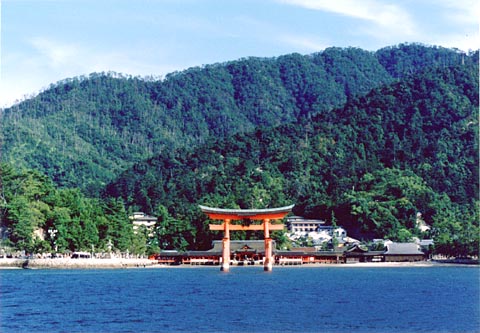History of
Itsukushima Shrine
Origin of Itsukushima Shrine

Itsukushima is located in the Takashima Sea in the west part of the Seto Inland Sea between Honshu and Shikoku and has a high mountain range of 530 m above sea level and for its mountaineering people of the surroundings are worshiped from the ancient times as objects of faith It is the island of God.
In the old days, the entire island centered on Mt. Misen was regarded as a theological body, and faith began from worshiping it far away from it, so it is considered that the shrine was gradually formed at the water's edge of the island. It is said that the foundation of the shrine is 593 years old. It is after 811 that it will appear on the stage of history, and it states that "God of Itokishima" is aligned with the name god in "Japan postscript", and money is being served from the Imperial family. Since then, through the Heian era, it will be known as a famous shrine of Aki's country.
Contrasting with Kiyomori and later construction

It is unknown when the construction of the shrine started at Itsukushima, but there is a document reporting to the court that 1168 (Jin'an 3), the priest owner Kagehiro Saeki did the construction of the shrine. Among them, Kagehiro Saeki says that in this construction, the size of the building such as the temple was increased, and the roof was made of cypress skin and part of the roof made from the plate was changed to the roof. It was a mistake that this construction was carried out under the auspices of the then powerful person Kiyomori. Moreover, it is considered to be the criterion of the scale and arrangement of the temple of Itsukushima shrine after that.
Kiyomori understands the wartime in Hogen / Heiji's turbulence and the subsequent promotion in central politics as the gift of the faith of Itsukushima Shrine. He positioned the shrine as the guardian god of the Heike Ichigon, and deepened his reverence more and more. He is pilgrims to the shrine as much as he can say for his political milestone in his lifetime.
The shrine that was built at this time entered the Kamakura period and flames up in 1207 (Tsunei 2) with a fire. It will be restored to 1215 (Jeong 3) eight years later, but it will be destroyed again in 1223 (Kodan 2). Its restarting was delayed to a certain extent, and it was finally completed in 1241 (Jinji 2).
The main shrines that remain at present are those that were built at this time.
Due to the large and magnificent shrine, it seems that it was difficult to rebuild the whole shrine temporarily. After this the maintenance of the shrine is planned by partial repair and rebuilding. In the Kamakura period, there was the asylum of theBakufu, but in Muromachi era the national aid like the previous generation ceased. Although Itsukushima Shrine was built on the sea, it was frequently subjected to wind and flood damage, but it gathered reverence from occasional powerful persons and influential people in the site, and it is restored each time. Besides that, new buildings were added besides the traditional shrine, and a landscape near the shrine was formed. In the year 1407, the Gojunoto was built, Tahoto in 1523, sessha Tenjin-sha Honden in 1556 was built. Even since entering the Momoyama period, Massha Hokoku-jinja Honden(senjokaku) was newly built in 1587.
In the retrofitting of the shrine, Massha Araebis-jinja Honden was rebuilt in 1441, Sessha Omoto-jinja Honden was rebuilt in 1523. The main hall was rebuilt in 1571 as the surroundings were polluted by the bloodshed case that occurred in 1569.
In addition, Sessha Marodo-jinja Honden was refurbished from 1430 to 1433.

The Great Torii is often recorded that it collapsed. It was reformatted to the present form by revival in 1547. Even after that, I changed it a couple of times, but the last time I rebuilt in 1875 after the damage was damaged by a strong wind in 1850 is the current the Great Torii.
Common people also begin worshiping Itsukushima
Since Itsukushima dominates the commercial and transportation of the Seto Inland Sea, the market began to stand in the island in the late Muromachi period, and the city area was also developing. Although Itsukushima Shrine has received reverence from the authority of each era, a temple near the summit of Mt.Misen, which is said to have opened the Kukai when it was early in the modern age, gathered private faith and frequent visits by people attending the pilgrimage.Together with the people who worshiped the contemporary first-ranking actors appeared in the events inside the island, a sophisticated culture from the city was also brought.
In this way it is thought that the ancient sacred island gradually faded away to the island of open faith which pilgrims also to the general people. As ordinary people visit to Itsukajima popularly, the landscape of the head of Itsukushima Shrine which develops from the coast to the sea on the backdrop of Mt. Misen hillside is a sight seeing reputation as a scenic spot in Japan. It was already being praised as one of Japan's three scenes in the middle of the Edo period.
Source / Government of Japan, Agency for Cultural Affairs, Environment Agency 1995 Recommendation letter written in World Heritage List · Cooperation / Itsukushima Shrine